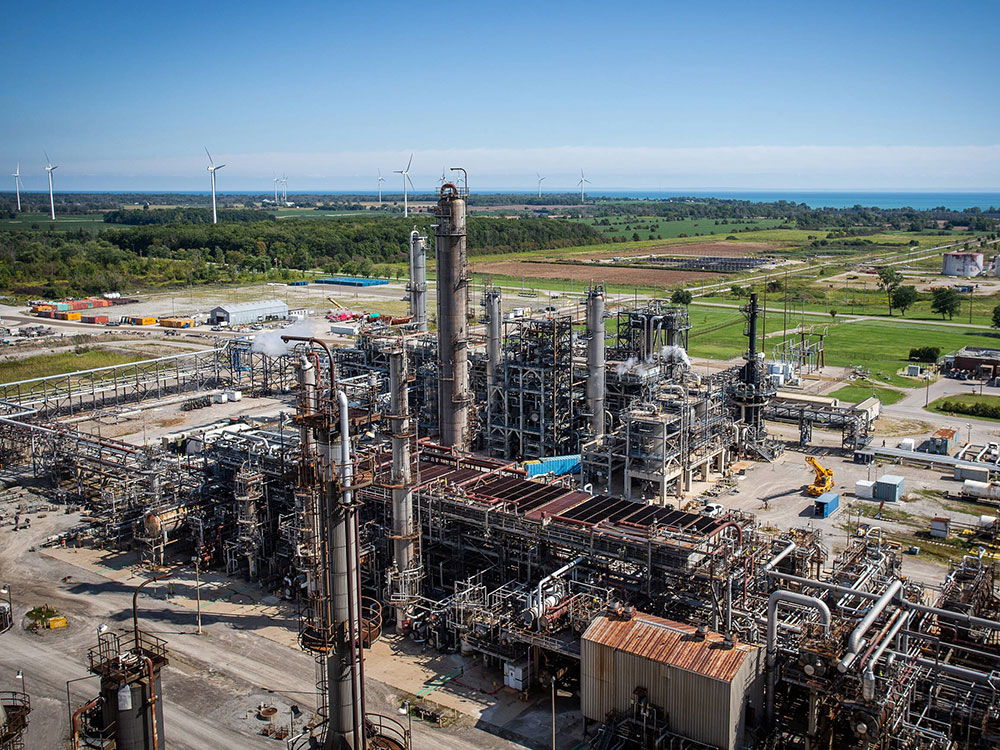In late June, Alberta Premier Jason Kenney flew to Washington, D.C., with the heads of major oilsands producers to make the case that Canada’s most carbon polluting industry cares deeply about fixing climate change.
The plan they presented to U.S. policy-makers sounded serious and ambitious: they would capture 20 million tonnes of carbon emissions a year from Canadian oilsands projects by 2030 and bury those emissions deep underground. “Right now, we have a label of, ‘Canada has dirty oil,’” Rhona DelFrari, chief sustainability officer at the oilsands company Cenovus Energy, told the Canadian Press. “We want to completely erase that label.”
Scrubbing the “dirty oil” label is a crucial goal for oilsands companies, because most of the bitumen they produce flows down to American refineries, and even modest efforts to wean the U.S. off that oil supply for climate reasons would harm the industry.
But the climate solution that Kenney and executives touted in the U.S. Capitol — known as carbon capture and storage — has a major disqualifying flaw. It may be technically feasible to bury oilsands emissions, but it is also prohibitively expensive, so much so that the technology doesn’t “appear to be economic” and would “achieve a relatively minor impact in reducing CO2 emissions.”
That blunt assessment didn’t come from an environmental group, but rather from a company leading the current carbon capture and storage effort: Imperial Oil.
More than three decades ago, the Exxon-owned oilsands producer undertook one of Canada’s first major studies of “underground carbon dioxide disposal.” The company’s findings, which were published in a newly reviewed 1991 Imperial Oil research paper, were not encouraging. The technology requires massive expenditures, would only mitigate a small fraction of Canada’s carbon output and comes with “large net costs to society,” Imperial concluded.
Imperial’s early negative assessments of the technology proved prescient. “The problems that they identified back then are the same ones we’re talking about now,” Keith Stewart, a senior energy strategist with Greenpeace Canada, told The Tyee.
A report last year from the Global CCS Institute, a proponent of the technology whose membership includes Exxon, found that the global capacity of carbon capture and storage projects was slightly lower in 2021 than it was a decade earlier.
“This represents a decade of very limited progress in terms of CCS project development,” noted a separate report from the Tyndall Centre for Climate Change Research, which identified poor economics and high financial risk as major barriers holding the technology back.
“Despite years of hype,” a libertarian think tank called the Manhattan Institute concluded in 2018, “CCS still costs too much and cannot come close to matching the scale of growing global carbon-dioxide emissions.” The institute has reportedly received more than $1 million in donations from Exxon.
Despite those pessimistic appraisals, Exxon’s subsidiary Imperial Oil belongs to a consortium of oilsands companies called the Pathways Alliance that argues carbon capture will help the industry “achieve net-zero greenhouse gas emissions by 2050.”
But the organization predicts a steep price tag. Deploying carbon capture and storage in the oilsands could cost $2.5 billion per year. This massive investment would shave off only 20 million tonnes per year of emissions by 2030 from an industry that annually emits 70 million tonnes. And Canadian oil producers like Cenovus are asking federal and provincial policy-makers to use taxpayer money to cover a huge part of the bill, saying “more help” is necessary.
So why is Imperial Oil, a top oilsands producer, continuing to push carbon capture and storage technology despite knowing for decades that it’s a subpar solution to the climate crisis? That’s simple, Stewart told The Tyee. “It extends the life of fossil fuels,” he said.
Imperial Oil began studying carbon capture technology in the 1990s as part of an early effort to understand the potential opportunities and costs of addressing climate change — a crisis that the company acknowledged was connected to its business model.
“As a significant Canadian producer, market and consumer of fossil fuels, Imperial Oil Ltd. is committed to participating in the public policy debate concerning the issue of global climate change,” reads a 1991 document that was obtained by researchers with the climate watchdog organization DeSmog.
The company estimated that in 1988 emissions from “fossil fuel combustion” in Canada were about 1.45 megatonnes per day. One way to deal with Alberta’s share of those emissions would be to construct “an extensive pipeline network” that could inject greenhouse gases captured from industrial sites “into deep subterranean formations,” Imperial explained.
The Exxon subsidiary concluded that “it would appear technically feasible” to develop such a network. It would take about five to 10 years and could be capable of burying 50,000 tonnes per day of carbon emissions — a “fairly minor” reduction compared to Canada’s overall emissions.
“But this reduction comes at a significant cost,” Imperial warned, adding that “a capital investment of approximately $7.5 billion would be required.”
The carbon disposal network would not generate enough profit to be “self-supporting.” Therefore, Imperial warned, the high costs of deploying the technology “would need to be shared not only by contributors of the emissions, but more broadly by society.”
And even then, it wouldn’t do much to fix climate change. Imperial concluded that the “ambitious” carbon capture and storage plans it studied would “achieve a relatively minor impact in reducing CO2 emissions.”
High costs, modest climate benefits and big public subsidies — these are the same issues still preventing carbon and storage from being deployed widely in Canada, Stewart argued. There are only a handful of such projects currently operating in the country, and one of them, Shell’s Quest plant in Alberta, emits more greenhouse gases than it buries according to the watchdog group Global Witness.
“The push for carbon capture is a way to distract us from the real solutions to climate change,” Stewart said, which include phasing out society’s use of oil and gas entirely.
Imperial Oil responded to a media request about its 1991 paper by pointing The Tyee towards a climate solutions report that it published in May 2022.
This more recent report touts carbon capture and storage as “a proven method to collect and safely store CO2 emissions permanently underground. Imperial views CCS as a critical technology to be utilized in our net-zero oilsands goal and is collaborating with government and other third parties to accelerate its deployment in the field.”
But Imperial acknowledges that current carbon capture plants operating worldwide are only burying about 40 million tonnes of carbon emissions per year, an amount eclipsed each year by the emissions released from Canada’s oilsands industry alone.
And in a “cautionary statement” at the end of the report, Imperial Oil warns readers of the report not to take its bold language about carbon capture too seriously. “The reference to any scenario, including any potential net-zero scenario, does not imply Imperial views any particular scenario as likely to occur,” the report reads.
After more than 30 years of studying carbon capture, the oilsands producer was still unsure if the business case for the technology actually makes sense. ![]()
Read more: Energy, Environment

















Tyee Commenting Guidelines
Comments that violate guidelines risk being deleted, and violations may result in a temporary or permanent user ban. Maintain the spirit of good conversation to stay in the discussion.
*Please note The Tyee is not a forum for spreading misinformation about COVID-19, denying its existence or minimizing its risk to public health.
Do:
Do not: